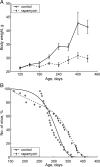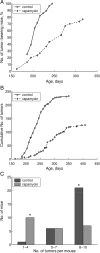Rapamycin extends maximal lifespan in cancer-prone mice
- PMID: 20363920
- PMCID: PMC2861075
- DOI: 10.2353/ajpath.2010.091050
Rapamycin extends maximal lifespan in cancer-prone mice
Abstract
Aging is associated with obesity and cancer. Calorie restriction both slows down aging and delays cancer. Evidence has emerged that the nutrient-sensing mammalian target of rapamycin (mTOR) pathway is involved in cellular and organismal aging. Here we show that the mTOR inhibitor rapamycin prevents age-related weight gain, decreases rate of aging, increases lifespan, and suppresses carcinogenesis in transgenic HER-2/neu cancer-prone mice. Rapamycin dramatically delayed tumor onset as well as decreased the number of tumors per animal and tumor size. We suggest that, by slowing down organismal aging, rapamycin delays cancer.
Figures


Similar articles
-
Lifespan extension and cancer prevention in HER-2/neu transgenic mice treated with low intermittent doses of rapamycin.Cancer Biol Ther. 2014 May;15(5):586-92. doi: 10.4161/cbt.28164. Epub 2014 Feb 20. Cancer Biol Ther. 2014. PMID: 24556924 Free PMC article.
-
Longevity, aging and rapamycin.Cell Mol Life Sci. 2014 Nov;71(22):4325-46. doi: 10.1007/s00018-014-1677-1. Cell Mol Life Sci. 2014. PMID: 25015322 Free PMC article. Review.
-
Rapamycin increases lifespan and inhibits spontaneous tumorigenesis in inbred female mice.Cell Cycle. 2011 Dec 15;10(24):4230-6. doi: 10.4161/cc.10.24.18486. Epub 2011 Dec 15. Cell Cycle. 2011. PMID: 22107964
-
The use of calorie restriction mimetics to study aging.Methods Mol Biol. 2013;1048:95-107. doi: 10.1007/978-1-62703-556-9_8. Methods Mol Biol. 2013. PMID: 23929100
-
Once again on rapamycin-induced insulin resistance and longevity: despite of or owing to.Aging (Albany NY). 2012 May;4(5):350-8. doi: 10.18632/aging.100461. Aging (Albany NY). 2012. PMID: 22683661 Free PMC article. Review.
Cited by
-
Hyper-mitogenic drive coexists with mitotic incompetence in senescent cells.Cell Cycle. 2012 Dec 15;11(24):4642-9. doi: 10.4161/cc.22937. Epub 2012 Nov 27. Cell Cycle. 2012. PMID: 23187803 Free PMC article.
-
Chronic rapamycin treatment or lack of S6K1 does not reduce ribosome activity in vivo.Cell Cycle. 2013 Aug 1;12(15):2493-504. doi: 10.4161/cc.25512. Epub 2013 Jul 1. Cell Cycle. 2013. PMID: 23839034 Free PMC article.
-
Hsp90 inhibitors and drug resistance in cancer: the potential benefits of combination therapies of Hsp90 inhibitors and other anti-cancer drugs.Biochem Pharmacol. 2012 Apr 15;83(8):995-1004. doi: 10.1016/j.bcp.2011.11.011. Epub 2011 Nov 22. Biochem Pharmacol. 2012. PMID: 22120678 Free PMC article. Review.
-
NCI's provocative questions on cancer: some answers to ignite discussion.Oncotarget. 2011 Dec;2(12):1352-67. doi: 10.18632/oncotarget.432. Oncotarget. 2011. PMID: 22267462 Free PMC article.
-
Therapeutic Antiaging Strategies.Biomedicines. 2022 Oct 8;10(10):2515. doi: 10.3390/biomedicines10102515. Biomedicines. 2022. PMID: 36289777 Free PMC article. Review.
References
-
- Guarente L, Kenyon C. Genetic pathways that regulate ageing in model organisms. Nature. 2000;408:255–262. - PubMed
-
- Demidenko ZN, Blagosklonny MV. Growth stimulation leads to cellular senescence when the cell cycle is blocked. Cell Cycle. 2008;7:3355–3361. - PubMed
-
- Vellai T, Takacs-Vellai K, Zhang Y, Kovacs AL, Orosz L, Muller F. Genetics: influence of TOR kinase on lifespan in C. elegans. Nature. 2003;426:620. - PubMed
-
- Jia K, Chen D, Riddle DL. The TOR pathway interacts with the insulin signaling pathway to regulate C. elegans larval development, metabolism and life span. Development. 2004;131:3897–3906. - PubMed
Publication types
MeSH terms
Substances
Grants and funding
LinkOut - more resources
Full Text Sources
Other Literature Sources
Molecular Biology Databases
Research Materials
Miscellaneous

